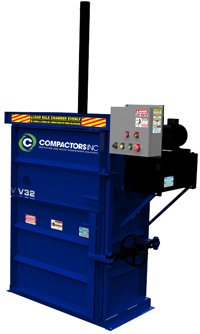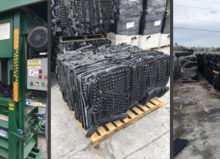What Type of Vertical Baler Do I Need?
 Choosing the right vertical baler for your business is crucial for efficient waste management and recycling operations. The selection depends on several factors, including the type and volume of materials you handle, available space, and specific operational needs. Below, we outline key considerations to help you determine the most suitable vertical baler, referencing models available through Compactors Inc.
Choosing the right vertical baler for your business is crucial for efficient waste management and recycling operations. The selection depends on several factors, including the type and volume of materials you handle, available space, and specific operational needs. Below, we outline key considerations to help you determine the most suitable vertical baler, referencing models available through Compactors Inc.
1. Type of Material
Different balers are designed to handle specific materials. It’s essential to identify the primary materials you intend to bale:
- Cardboard (OCC): For businesses primarily dealing with cardboard, models like the V63OCC Vertical Baler are ideal. This 60” Vertical Downstroke Baler is configured to produce mill-size, marketable bales of corrugated materials, handling up to 1,000 lbs per bale.
- Plastic Film and Shrink Wrap: If your operations involve a significant amount of plastic film, the V32 Vertical Baler model is suitable. This standard high-density baler is designed for organizations that recycle OCC or plastic film, producing bales up to 250 lbs.
- Non-Ferrous Metals: For handling materials like aluminum cans or siding, the V63HD Vertical Baler model is appropriate. This multi-material machine can bale paper, plastic, fiber, OCC, and non-ferrous metals, producing bales up to 1,100 lbs.
2. Volume of Material
Assessing the volume of material processed daily is vital:
- Low to Moderate Volume: For smaller operations, the V32 Vertical Baler producing bales up to 250 lbs, is efficient and space-saving.
- High Volume: Larger facilities may require the V63XHD Vertical Baler model, capable of producing bales up to 1,300 lbs, suitable for high volumes or tough materials.
3. Space Constraints
Consider the available space for the baler:
- Limited Space: The V43HD Vertical Baler model, with a compact footprint, is ideal for operations with width restrictions, producing bales up to 800 lbs.
- Ample Space: Facilities with more room can opt for larger models like the V63HD Vertical Baler, which, while larger, offers higher capacity and bale weight.
4. Bale Size and Weight Requirements
Determine the preferred bale size and weight for handling and transportation:
- Standard Mill Size Bales: The V63OCC Vertical Baler produces standard 60” x 30” x 48” bales, up to 1,000 lbs, facilitating efficient transport and sale.
- Smaller Bales: For easier handling, the V32 Vertical Baler produces 36” x 24” x 30” bales, up to 250 lbs.
5. Operational Features
Evaluate features that enhance efficiency and safety:
- Automatic Bale Ejection: Models like the V63HD Vertical Baler include semi-automatic dual chain-ejection systems for easy bale removal.
- Safety Mechanisms: Ensure the baler has essential safety features, such as cylinder safety platen cables and concealed limit switches, as found in the V63OCC Vertical Baler model.
Conclusion
Selecting the appropriate vertical baler involves a thorough assessment of your material types, processing volume, space availability, and specific operational needs. Compactors Inc. offers a diverse range of balers to accommodate various business requirements. For personalized assistance, consider reaching out to our experts who can guide you to the best machine for your application.



